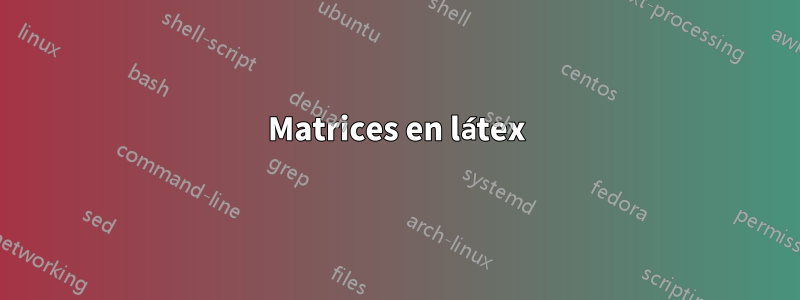
Intentando crear una matriz usando el siguiente marcado:
\begin{figure}
\centering
\[
\begin{blockarray}{cccccccc}
I & like & nlp & mlpr & enjoy & reading & books \\
\begin{block}{[ccccccc]c}
1 & 1 & 1 & 1 & 1 & 1 & 1 & I \\
1 & 1 & 1 & 1 & 1 & 1 & 1 & like \\
1 & 1 & 1 & 1 & 1 & 1 & 1 & nlp \\
1 & 1 & 1 & 1 & 1 & 1 & 1 & mlpr \\
1 & 1 & 1 & 1 & 1 & 1 & 1 & enjoy \\
1 & 1 & 1 & 1 & 1 & 1 & 1 & reading \\
1 & 1 & 1 & 1 & 1 & 1 & 1 & books \\
\end{block}
\end{blockarray}
\]
\caption{A caption to the entire figure}
\end{figure}
El resultado que obtengo es el siguiente:
Como puede ver, las columnas de la matriz están espaciadas de manera desigual. Sería fantástico si pudiera conseguir columnas espaciadas uniformemente.
¿Algunas ideas?
Respuesta1
Advertencia: no soy blkarrayun experto ;-)
Sin embargo, es posible definir un nuevo tipo de columna (digamos B) para blockarrayel cual se utiliza el mismo ancho para todas las columnas con este especificador.
Dado que hay 7 columnas con esta característica, se podrían acortar cccccccy reemplazar *{7}Bcomo en los entornos tabulares habituales.
Tengo que averiguar si es \BAnewcolumntypecompatible con el tipo de columna con un argumento.
\documentclass{article}
\usepackage{mathtools}
\usepackage{blkarray}
\BAnewcolumntype{B}{>{\centering}p{1cm}}
\begin{document}
\begin{figure}
\centering
$
\begin{blockarray}{cccccccc}
\text{I} & \text{like} & \text{nlp} & \text{mlpr} & \text{enjoy} & \text{reading} & \text{books} \\
\begin{block}{[*{7}B]c}
1 & 1 & 1 & 1 & 1 & 1 & 1 & \text{I} \\
1 & 1 & 1 & 1 & 1 & 1 & 1 & \text{like} \\
1 & 1 & 1 & 1 & 1 & 1 & 1 & \text{nlp} \\
1 & 1 & 1 & 1 & 1 & 1 & 1 & \text{mlpr} \\
1 & 1 & 1 & 1 & 1 & 1 & 1 & \text{enjoy} \\
1 & 1 & 1 & 1 & 1 & 1 & 1 & \text{reading} \\
1 & 1 & 1 & 1 & 1 & 1 & 1 & \text{books} \\
\end{block}
\end{blockarray}
$
\caption{A caption to the entire figure}
\end{figure}
\end{document}
Respuesta2
El tabstackenginepaquete tiene una opción de ancho fijo para matrices, que empleo aquí. Debido a eso, simplemente necesitaba hacer una sola entrada en la matriz "1" del mismo ancho que la palabra "lectura" y el resto se resolvió. Lo logré con \tmpbox.
El paquete también permite apilar texto o matemáticas, lo que usé aquí para apilar el texto como texto y los números como matemáticas.
\documentclass{article}
\usepackage{tabstackengine}
\setstackEOL{\cr}
\setstacktabbedgap{1ex}
\fixTABwidth{T}
\begin{document}
\begin{figure}
\centering
\[
\stackText
\setbox0=\hbox{reading}
\savestack{\tmpbox}{\makebox[\wd0]{$1$}}
\savestack{\toprow}{\tabbedCenterstack{I & like & nlp & mlpr & enjoy & reading & books}}
\ensurestackMath{
\stackon{\bracketMatrixstack{
\tmpbox & 1 & 1 & 1 & 1 & 1 & 1 \cr
1 & 1 & 1 & 1 & 1 & 1 & 1 \cr
1 & 1 & 1 & 1 & 1 & 1 & 1 \cr
1 & 1 & 1 & 1 & 1 & 1 & 1 \cr
1 & 1 & 1 & 1 & 1 & 1 & 1 \cr
1 & 1 & 1 & 1 & 1 & 1 & 1 \cr
1 & 1 & 1 & 1 & 1 & 1 & 1
}}{\toprow}}
\Centerstack{ I \cr like \cr nlp \cr mlpr \cr enjoy \cr reading \cr books}
\]
\caption{A caption to the entire figure}
\end{figure}
\end{document}
El espacio entre columnas se establece en 1ex con \setstacktabbedgap{1ex}. Si se desea que el salto de línea de base entre filas sea mayor, \setstackgap{L}{1.2\baselineskip}se podría agregar la línea al preámbulo para lograr el siguiente resultado:
Finalmente, se podría alinear a la izquierda la columna de palabras de la derecha agregando un [l]argumento opcional al archivo \Centerstack.
Respuesta3
Una variante con una columna menos, y 7 bloques, con \Right{.}{text}al final del preámbulo de cada bloque. También uso el eqparboxpaquete para asegurar columnas de igual ancho, sin tener que encontrar mediante pruebas y errores cuál será el tamaño correcto:
\documentclass{article}
\usepackage{mathtools}
\usepackage{blkarray}
\usepackage{eqparbox}
\BAnewcolumntype{B}{>{\centering}p{1cm}}
\begin{document}
\begin{figure}
\centering\makeatletter\setlength\tabcolsep{-10pt}\BA@colsep =1pt\makeatother
$
\begin{blockarray}{*{7}{c}}
\eqmakebox[C]{I} & \eqmakebox[C]{like} & \eqmakebox[C]{nlp} & \eqmakebox[C]{mlpr} & \eqmakebox[C]{enjoy} & \eqmakebox[C]{reading} & \eqmakebox[C]{books} \\
\begin{block}{*{7}{c}\Right{.}{I}}
1 & 1 & 1 & 1 & 1 & 1 & 1 \\
\end{block}
\begin{block}{*{7}{c}\Right{.}{like}}
1 & 1 & 1 & 1 & 1 & 1 & 1 \\
\end{block}
\begin{block}{*{7}{c}\Right{.}{nlp}}
1 & 1 & 1 & 1 & 1 & 1 & 1 \\
\end{block}
\begin{block}{*{7}{c}\Right{.}{mlpr}}
1 & 1 & 1 & 1 & 1 & 1 & 1 \\
\end{block}
\begin{block}{*{7}{c}\Right{.}{enjoy}}
1 & 1 & 1 & 1 & 1 & 1 & 1 \\
\end{block}
\begin{block}{*{7}{c}\Right{.}{reading}}
1 & 1 & 1 & 1 & 1 & 1 & 1 \\
\end{block}
\begin{block}{*{7}{c}\Right{.}{books}}
1 & 1 & 1 & 1 & 1 & 1 & 1 \\
\end{block}
\end{blockarray}
$
\caption{A caption to the entire figure}
\end{figure}
\end{document}







